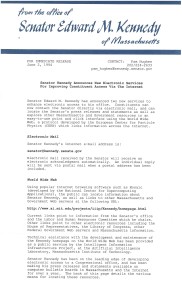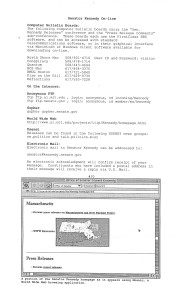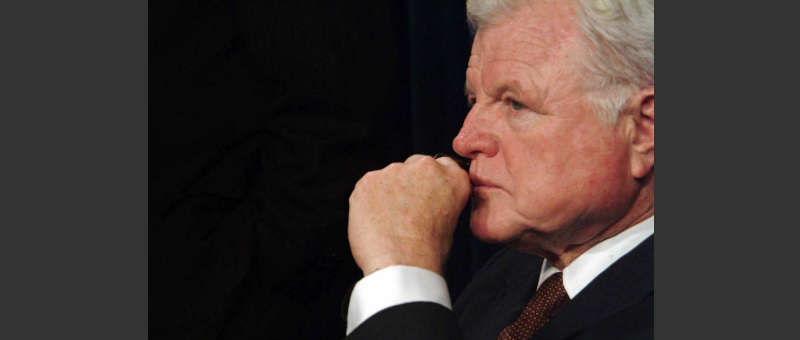Guest article! Chris Casey writes on the 20th Anniversary of the first Congressional website, which he helped bring to life. This article first appeared on June 2, 2014 on Casey.com. UPDATE: check out screenshots from this and other early 90s Ted Kennedy congressional and campaign websites. Bink tag? Check!.
At its current rate of growth, at some point this month, June of 2014, the number of websites on the Internet will surpass the one billion mark. The first website was launched on August 6, 1991 by the inventor of the World Wide Web, Tim Berners Lee. By mid-1994 there were 2,738 websites on the Web. And by the end of that year there were more than 10,000.
On June 2, 1994, the office of Massachusetts Senator Ted Kennedy released a press release announcing the launch of their official website, the first for any member of Congress. It was developed and hosted by the Artificial Intelligence Lab at the Massachusetts Institute of Technology. The same release shared a public email address for the Senator, joining just a handful of Senators accepting email from the public by that point.
And, it detailed the Senator’s previous means of online outreach to his constituents, including a network of dial up bulletin boards, ftp and gopher servers, and postings in Usenet newsgroups. Ed note: Chris is being shy. He was deeply involved in making all of this happen, which is why we’re listening to him today.
| Press release announcing the launch of Sen. Kennedy’s website, June 2, 1994. | |
 |
 |
Being old enough to remember, and being able to remember, are two different things. And it’s truly difficult to recall the World Wide Web in mid-1994. Before Amazon.com, craigslist and eBay. Before Netflix, Google or PayPal. Before Whitehouse.gov, and only shortly after Yahoo. Every baby born since then is arriving into a much-more-webbed world than their parents ever imagined. Every minute of the day approximately 255 babies are born worldwide. And in that same minute on the World Wide Web, approximately 571 new websites are created.
When the Senate’s own website was launched, almost a year and a half after Kennedy’s in October 1995, Senator John Warner of Virginia, then chairman of the Senate Rules Committee, thanked the many staff of the Rules Committee and Sergeant at Arms and Secretary’s offices involved in the effort. And he also included, “Additional thanks to many of those Senators and their high-technology staff members who were early adopters of this emerging technology, and who indeed gave us the impetus to move forward to this day.”
Twenty years ago today I was 28 years old and working for Sen. Edward Kennedy of Massachusetts as his Systems Administrator. I was excited by the possibilities of exploring the intersection of technology and politics, and I was very fortunate to collaborate with others much smarter than myself to push the boundaries of what had yet been done. Jeff Hecker, Jock Gill, John Mallery, Eric Loeb, and Laura Quinn were the firsts among so many others I’ve been able to work with over more than 20 years in online politics, and I’m very grateful to each of them.
The first long distance telegraph message from the U.S. Capitol was sent by its inventor, Samuel Morse, asking his recipient the deep question, “What hath God wrought?”. He didn’t get an answer, but a question in reply, “What is the news from Washington?”. Today, much of the news from Washington comes from our modern telegraph, the Internet. How will it arrive in another 20 years, or another 100?
When Senator Kennedy passed away in 2009, I wrote this remembrance about his impact on online politics. If he had not become the first member of Congress on the web 20 years ago, some other member would eventually have been some time later. But Kennedy was, and among the very many much larger accomplishments in his long career in public service, it’s still one worth remembering.

